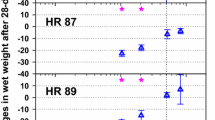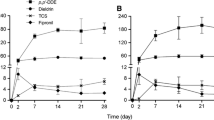Abstract
The present study was conducted to evaluate a sediment toxicity and bioavailability test with the polychaete Arenicola marina as a potential tool to assess sediments contaminated by oil spills. A bioassay using the lugworm Arenicola marina was carried out in order to determine toxicity and bioaccumulation associated with the contaminants present in the fuel oil extracted from a sank tanker. After 10 and 21 days of exposure to sediments with different proportions of fuel oil (0.5, 1, 2, 4 and 8%) polychaetes were sampled to determine the mortality and the levels of individual PAHs in the organisms. During the experiment, mortality was recorded and the concentration (percentage of fuel oil) that provokes the mortality of the 50% of the Arenicola marina population exposed was calculated for both sampling dates (LC50(10) = 6.4%; LC50(21) = 2.4%). Bioaccumulation was mainly produced for fluoranthene, pyrene, benzo(b)fluoranthene and benzo(k)fluoranthene, whereas phenantrene and anthracene where initially accumulated and then metabolized. The results obtained in the present study suggest Arenicola marina can be a suitable species for assessing PAHs toxicity and bioaccumulation as part of oil spill management.
Similar content being viewed by others
References
Albers, P. H. (2003). Petroleum and polycyclic aromatic hydrocarbons, in Handbook of Ecotoxicology. Boca Raton: Lewis Publishers CRC Press LLC.
Alzaga, R., Montuori, P., Ortiz, L., Bayona, J. M., & Albaiges, J. (2004). Fast solid-phase extraction-gas chromatography-mass spectrometry procedure for oil fingerprinting. Application to the Prestige oil spill. Journal of Chromatography A, 1025, 133–138.
Babson, J. R., Russo-Rodriguez, S. E., Wattley, R. V., Bergstein, P. L., Rastetter, W. H., Liber, H. L., et al. (1986). Microsomal activation of fluoranthene to mutagenic metabolites. Toxicology and Applied Pharmacology, 85, 355–366.
Bach, L., Palmqvist, A., Rasmussen, L. J., & Forbes, V. E. (2005). Differences in PAH tolerance between Capitella species: Underlying biochemical mechanisms. Aquatic Toxicology, 74, 307–319.
Bat, L., & Raffaelli, D. (1997). Sediment toxicity testing: A bioassay approach using the amphipod Corophium volutator and the polychaete Arenicola marina. Journal of Experimental Marine Biology and Ecology, 226, 217–239.
Blanco, C. G., Prego, R., Azpíroz, M. D. G., & Fernández-Domínguez, I. (2006). Hydrocarbon characterization of surface sediments in the Ria Laxe and its relation with the Pretige fuel-oil spill (NW Iberian Penninsula). Ciencias Marinas, 22, 429–437.
Casado-Martínez, M. C., Fernández, N., Forja, J. M., & DelValls, T. A. (2007). Liquid versus solid phase bioassays for dredged material toxicity assessment. Environment International, 33, 456–462.
Christensen, M., Andersen, O., & Banta, G. T. (2002). Metabolism of pyrene by the polychaetes Nereis diversicolor and Arenicola marina. Aquatic Toxicology, 58, 15–25.
DelValls, T. A. (2003). The oil spill produced by the tanker Prestige (13/11/2002): Impact assessment of the northwest coast of the Iberian Peninsula. Ciencias Marinas, 29(1), i–iii.
Driscoll, S. K., & McElroy, A. E. (1996). Bioaccumulation and metabolism of benzo[a]pyrene in three species of polychaete worms. Environmental Toxicology and Chemistry, 15, 1401–1410.
Grant, A., & Briggs, A. D. (2002). Toxicity of sediments from around a North Sea oil platform: are metals or hydrocarbons responsible for ecological impacts? Marine Environmental Research, 53, 95–116.
Kaag, N. H. B. M., Foekema, E. M., Scholten, M. C. Th., & Van Straalen, N. M. (1996). Comparison of contaminant accumulation in three species of marine invertebrates with different feeding habits. Environmental Toxicology and Chemistry, 16(5), 837–842.
Kaag, N. H. B. M., Foekema, E. M., Scholten, M. C. Th., & Van Straalen, N. M. (1997). Comparison of contaminant accumulation in three species of marine invertebrates with different feeding habits. Environmental Toxicology and Chemistry, 16, 837–842.
Kaag, N. H. B. M., Scholten, M. C. Th., & Van Straalen, N. M. (1998). Factors affecting PAH residues in the lugworm Arenicola marina a sediment feeding polychaete. Journal of Sea Research, 40, 251–261.
Lamoureux, E. M., & Brownawell, B. J. (1998). Chemical and biological availability of sediment-sorbed hydrophobic organic contaminants. Environmental Toxicology and Chemistry, 18(8), 1733–1741.
Landrum, P. F. (1989). Bioavailability of polycyclic aromatic hydrocarbons sorbed to sediments for the amphipod Pontoporeia hoyi. Environmental Science & Technology, 23, 588–595.
Landrum, P. F., Lotufo, G. R., Gossiaux, D. C., Gedeon, M. L., & Lee, J. H. (2003). Bioaccumulation and critical body residue of PAHs in the amphipod, Diporeia spp.: Additional evidence to support toxicity additivity for PAHs mixtures. Chemosphere, 51, 481–489.
Loring, D. H., & Rantala, R. T. T. (1992). Methods for the geochemical analyses of marine sediments and suspended particulate matter. Earth-Science Reviews, 32, 235–283.
Matthiessen, P., Bifield, S., Jarrett, F., Kirby, F., Law, R. J., McMinn, W. R., et al. (1998). An assessment of sediment toxicity in the River Tyne Estuary, UK by means of bioassays. Marine Environmental Research, 45, 1–15.
National Oceanic and Atmospheric Administration (1999). Sediment quality guidelines developed for the national status and trend programs.
Neff, J. M. (1979). Polycyclic aromatic hydrocarbons in the aquatic environment: Source, fates, and biological effects. London, UK: Applied Science.
Neff, J. M. (2002). Polyciclic aromatic hydrocarbons in the ocean, in Bioaccumulation in Marine Organisms. New York: Elsevier, p. 452.
Oslo-Paris Commission (1995). Report of the workshop on biological effects monitoring techniques. Aberdeen, Scotland, 2–6 October.
Penry, D. H., & Weston, D. P. (1998). Digestive determinants of Benzo[a]pyrene and Phenantrene Bioaccumulation by deposit-feeding polychaete. Environmental Toxicology and Chemistry, 17(11), 2254–2265.
Rastetter, W. H., Nachbar, R. B., Russo-Rodriguez, S. E., Wattley, R. V., Thilly, W. G., Andon, B. M., et al. (1982). Fluoranthene: Synthesis and mutagenicity of four diol epoxides. Journal of Organic Chemistry, 47, 4873–4878.
Riba, I., Zitko, V., Forja, J. M., & DelValls, T. A. (2003). Deriving sediment quality guidelines in the Guadalquivir estuary associated with the Aznalcóllar mining spill: A comparison of different approaches. Ciencias Marinas, 29(3).
Rossi, S. S., & Neff, J. M. (1978). Toxicity of polynuclear aromatic hydrocarbons to the polychaete Neanthes arenaceodentata. Marine Pollution Bulletin, 9, 220–223.
Rust, J. A., Burgess, R. M., Brownawell, B. J., & McElroy, A. E. (2004a). Relationship between metabolism and bioaccumulation of benzo[a]pyrene in benthic invertebrates. Environmental Toxicology and Chemistry, 23(11), 2587–2593.
Rust, J. A., Burgess, R. M., McElroy, A. E., Cantwell, M. G., & Brownawell, B. J. (2004b). Influence of soot carbon on the bioaccumulation of sediment-bound polycyclic aromatic hydrocarbons by marine benthic invertebrates: An interspecies comparison. Environmental Toxicology and Chemistry, 23(11), 2594–2603.
Selck, H., Palmqvist, A., & Forbes, V. E. (2003). Uptake, depuration and toxicity of dissolved and sediment-bound flouranthene in the polychaete Capitella sp. I. Environmental Toxicology and Chemistry, 22(10), 2354–2363.
Spacie, A., & Hamelink, J. L. (1995). Appendix D, bioaccumulation. In G. M. Rand (Ed), Fundamentals of Aquatic Toxicology (pp. 1052–1082). Washington DC: Taylor & Francis.
Swartz, R. C., Schults, D. W., DeWitt, T. H., Ditsworth, G. R., & Lamberson, J. O. (1990). Toxicity of fluoranthene in sediment to marine amphipods: A test of the equilibrium partitioning approach to sediment quality criteria. Environmental Toxicology and Chemistry, 9, 1074–1080.
US Environmental Protection Agency (1984). Test methods for evaluating solid waste, physical/chemical methods. Office of Solid Waste and Emergency Response, Washington, DC. Third Edition. US Environmental Protection Agency. EPA 530/SW–846.
Varanasi, U., Reichert, W. L., Stein, J. E., Brown, D. W., & Sanborn, H. R. (1985). Bioavailability and biotransformation of aromatic hydrocarbons in benthic organisms exposed to sediment from an urban estuary. Environmental Science & Technology, 19, 836–841.
Author information
Authors and Affiliations
Corresponding author
Rights and permissions
About this article
Cite this article
Morales-Caselles, C., Ramos, J., Riba, I. et al. Using the polychaete Arenicola marina to determine toxicity and bioaccumulation of PAHS bound to sediments. Environ Monit Assess 142, 219–226 (2008). https://doi.org/10.1007/s10661-007-9926-5
Received:
Accepted:
Published:
Issue Date:
DOI: https://doi.org/10.1007/s10661-007-9926-5




